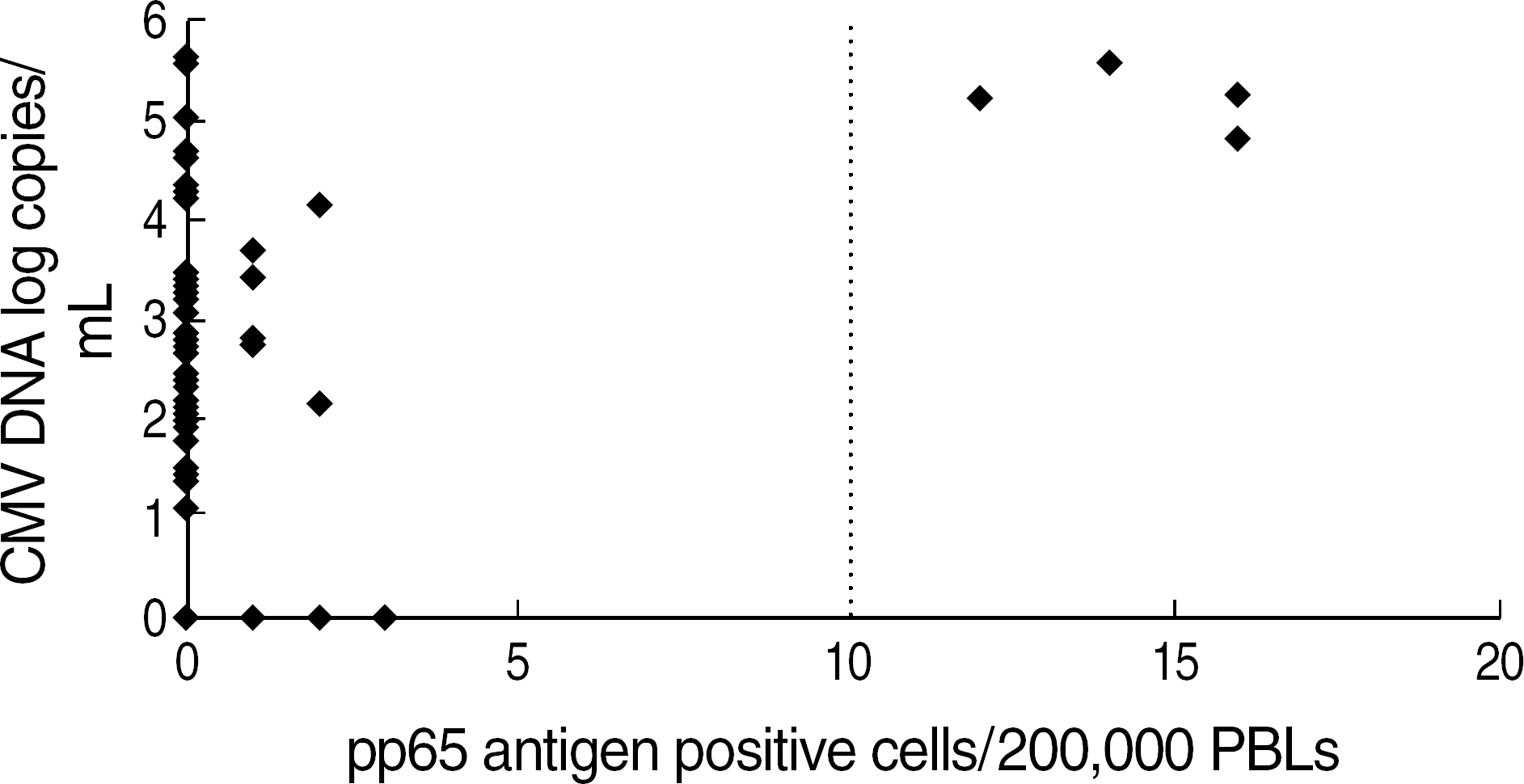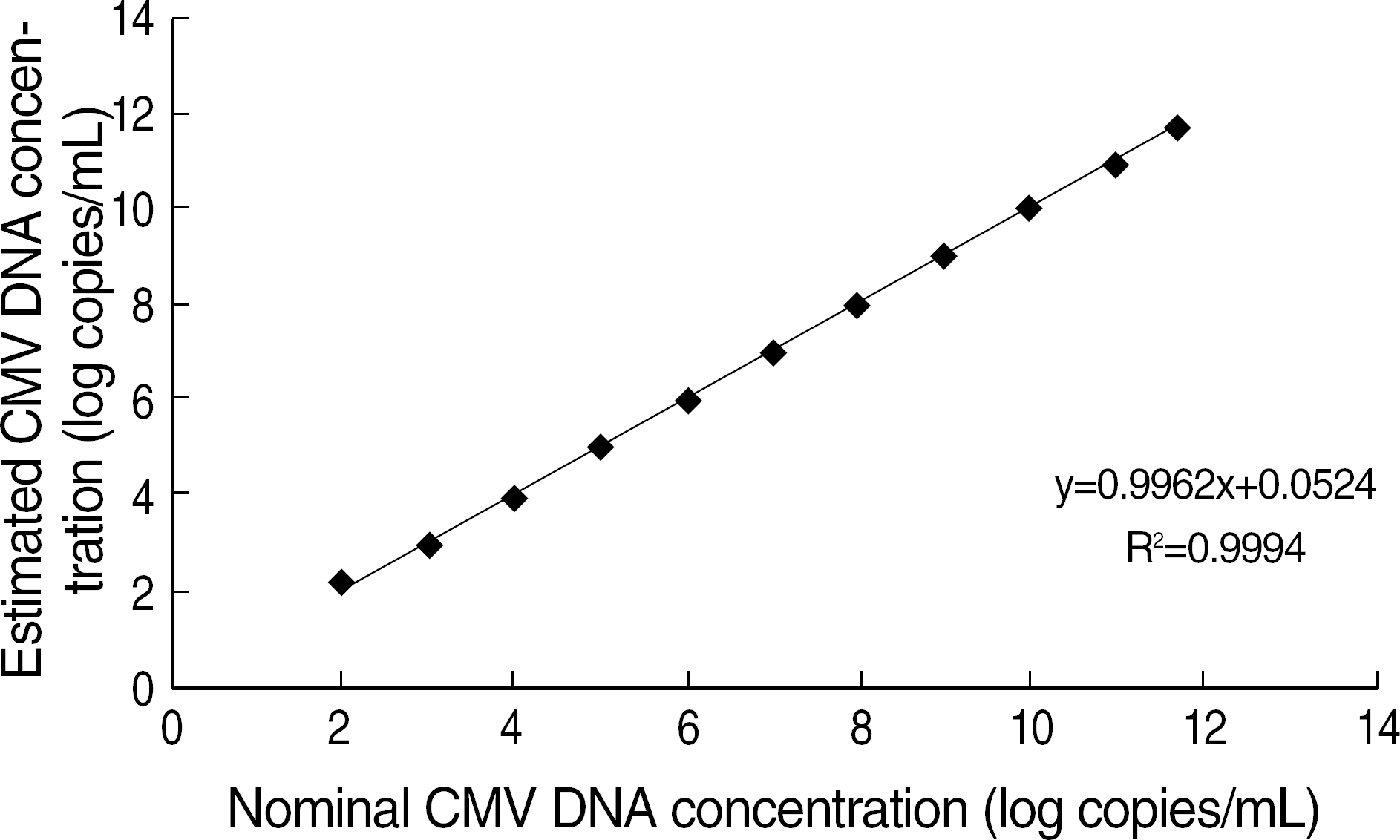Abstract
Background
Rapid and accurate laboratory tests are essential to detect cytomegalovirus (CMV) infections in solid organs and haematopoietic stem cell transplant recipients. We assessed the realtime quantitative PCR (RQ-PCR) technology for its usefulness in detecting CMV DNA.
Methods
We evaluated the analytical performance of CMV RQ-PCR using Real-Q Cytomegalovirus Quantification kit (BioSewoom Inc., Korea). To evaluate its clinical utility, we also compared it to pp65 antigenemia test, an immunostaining method, on 343 samples of total 84 patients, including 63 transplant recipients.
Results
The detection limit of RQ-PCR was 63 copies/mL and none of hepatitis B virus, hepatitis C virus, or human immunodeficiency virus showed a cross-reactivity with CMV. Total coefficient of variation (CV) was 10.4–19.5%. It detected CMV DNA in a linear range from 1 × 102 to 5 × 1011 copies/mL (P<10-13, R2=0.9994). The qualitative positive rates of pp65 antigenemia test and RQ-PCR were 4.7%, 16.3%, respectively and concordance rate between the two tests was 84.8% (K =0.221, P<10-6). In comparison of quantitative results, the correlation between two tests was significant (r= 0.45, P<10-17). In comparison among three groups by pp65 antigen level, CMV DNA level obtained with RQ-PCR increased significantly (P<10-3 and P<10-7, respectively).
Conclusions
The RQ-PCR is easier to perform than the immunostaining method, has good analytical performance and reflects the blood level of viral DNA well. It may be a new method substituting the pp65 antigenemia test. Further studies determining RQ-PCR value starting pre-emptive therapy will be required.
References
1. Paya CV. Prevention of cytomegalovirus disease in recipients of solid-organ transplants. Clin Infect Dis. 2001; 32:596–603.
2. Boeckh M, Boivin G. Quantitation of cytomegalovirus: methodologic aspects and clinical applications. Clin Microbiol Rev. 1998; 11:533–54.

3. Camargo LF, Uip DE, Simpson AA, Caballero O, Stolf NA, Vilas-Boas LS, et al. Comparison between antigenemia and a quantitative-competitive polymerase chain reaction for the diagnosis of cytomegalovirus infection after heart transplantation. Transplantation. 2001; 71:412–7.
4. Guiver M, Fox AJ, Mutton K, Mogulkoc N, Egan J. Evaluation of CMV viral load using TaqMan CMV quantitative PCR and comparison with CMV antigenemia in heart and lung transplant recipients. Transplantation. 2001; 71:1609–15.

5. Monte PD, Lazzarotto T, Ripalti A, Landini MP. Human cytomegalovirus infection: a complex diagnostic problem in which molecular biology has induced a rapid evolution. Intervirology. 1996; 39:193–203.

6. Delgado R, Lumbreras C, Alba C, Pedraza MA, Otero JR, Gomez R, et al. Low predictive value of polymerase chain reaction for diagnosis of cytomegalovirus disease in liver transplant recipients. J Clin Microbiol. 1992; 30:1876–8.

7. Schaade L, Kockelkorn P, Ritter K, Kleines M. Detection of cytomegalovirus DNA in human specimens by LightCycler PCR. J Clin Microbiol. 2000; 38:4006–9.

8. Ljungman P, Griffiths P, Paya C. Definitions of cytomegalovirus infection and disease in transplant recipients. Clin Infect Dis. 2002; 34:1094–7.

9. Patel R, Snydman DR, Rubin RH, Ho M, Pescovitz M, Martin M, et al. Cytomegalovirus prophylaxis in solid organ transplant recipients. Transplantation. 1996; 61:1279–89.

10. Kearns AM, Guiver M, James V, King J. Development and evaluation of a real-time quantitative PCR for the detection of human cytomegalovirus. J Virol Methods. 2001; 95:121–31.

11. Mandell GL, Bennett JE, editors. Principles and practices of infectious diseases. 6th ed.Philadelphia: Elsevier Churchill Livingstone;2005. p. 1786–7.
12. Meyers JD, Flournoy N, Thomas ED. Risk factors for cytomegalovirus infection after human marrow transplantation. J Infect Dis. 1986; 153:478–88.

13. Masur H, Whitcup SM, Cartwright C, Polis M, Nussenblatt R. Advances in the management of AIDS-related cytomegalovirus retinitis. Ann Intern Med. 1996; 125:126–36.

14. Nokta MA, Holland F, De Gruttola V, Emery VC, Jacobson MA, Griffiths P, et al. Cytomegalovirus (CMV) polymerase chain reaction profiles in individuals with advanced human immunodeficiency virus infection: relationship to CMV disease. J Infect Dis. 2002; 185:1717–22.

15. Emery VC, Sabin CA, Cope AV, Gor D, Hassan-Walker AF, Griffiths PD. Application of viral-load kinetics to identify patients who develop cytomegalovirus disease after transplantation. Lancet. 2000; 355:2032–6.

16. Sia IG, Wilson JA, Espy MJ, Paya CV, Smith TF. Evaluation of the COBAS AMPLICOR CMV MONITOR test for detection of viral DNA in specimens taken from patients after liver transplantation. J Clin Microbiol. 2000; 38:600–6.

17. Allice T, Enrietto M, Pittaluga F, Varetto S, Franchello A, Marchiaro G, et al. Quantitation of cytomegalovirus DNA by real-time polymerase chain reaction in peripheral blood specimens of patients with solid organ transplants: comparison with end-point PCR and pp65 antigen test. J Med Virol. 2006; 78:915–22.

18. Piiparinen H, Lautenschlager I. Quantitative TaqMan assay for the detection and monitoring of cytomegalovirus infection in organ transplant patients. Methods Mol Biol. 2006; 335:147–56.

19. Martin-Davila P, Fortun J, Gutierrez C, Marti-Belda P, Candelas A, Honrubia A, et al. Analysis of a quantitative PCR assay for CMV infection in liver transplant recipients: an intent to find the optimal cut-off value. J Clin Virol. 2005; 33:138–44.
20. Hernando S, Folgueira L, Lumbreras C, San Juan R, Maldonado S, Prieto C, et al. Comparison of cytomegalovirus viral load measure by real-time PCR with pp65 antigenemia for the diagnosis of cytomegalovirus disease in solid organ transplant patients. Transplant Proc. 2005; 37:4094–6.

21. Fan J, Ma WH, Yang MF, Xue H, Gao HN, Li LJ. Real-time fluorescent quantitative PCR assay for measuring cytomegalovirus DNA load in patients after haematopoietic stem cell transplantation. Chin Med J. 2006; 119:871–4.

Fig. 2.
Quantitative comparison of pp65 antigen values and CMV DNA levels obtained by RQ-PCR (r=0.45, P<10-17).

Table 1.
Classification of the patients in this study
Table 2.
Analytical sensitivity of Real-Q CMV Quantification kit
| Input CMV (copies/mL) |
Result |
||
|---|---|---|---|
| Replicates | Positive reaction | % | |
| 10,000 | 150 | 150 | 100 |
| 5,000 | 150 | 150 | 100 |
| 1,000 | 150 | 150 | 100 |
| 500 | 150 | 150 | 100 |
| 100 | 150 | 150 | 100 |
| 75 | 150 | 145 | 97 |
| 50 | 150 | 130 | 87 |
Table 3.
Analytical specificity of Real-Q CMV Quantification kit
| CMV (VIC)* | Internal control (FAM)* | |
|---|---|---|
| Hepatitis B virus | − | + |
| Hepatitis C virus 1a | − | + |
| Hepatitis C virus 1b | − | + |
| Hepatitis C virus 2a | − | + |
| Hepatitis C virus 2b | − | + |
| Hepatitis C virus 3a | − | + |
| Hepatitis C virus 3b | − | + |
| Hepatitis C virus 4 | − | + |
| Hepatitis C virus 4h | − | + |
| Hepatitis C virus 5a | − | + |
| Hepatitis C virus 6a | − | + |
| HIV A | − | + |
| HIV B | − | + |
| HIV C | − | + |
| HIV D | − | + |
| HIV E | − | + |
| HIV F | − | + |
| HIV G | − | + |
| HIV H | − | + |
Table 4.
Comparison between pp65 antigenemia and CMV DNA obtained with RQ-PCR among 343 samples
|
pp65 antigenemia* |
Total | ||
|---|---|---|---|
| Positive | Negative | ||
| CMV DNA* | |||
| Positive | 10 (2.9%) | 46 (13.4%) | 56 (16.3%) |
| Negative | 6 (1.7%) | 281 (81.9%) | 287 (83.7%) |
| Total | 16 (4.7%) | 327 (95.3%) | 343 (100%) |
Table 5.
CMV DNA levels according to the pp65 antigen levels
| Patient group (pp65 antigen positive cells/200,000 PBLs, N) | CMV DNA levels* (Log10 copies/mL) |
|---|---|
| 0 (N=327) | 0.38±1.03 |
| 1–10 (N=12) | 1.59†±1.73 |
| 11–20 (N=4) | 5.23†±0.31 |
Table 6.
pp65 antigenemia and CMV DNA levels according to the clinical status of CMV infection
| pp65 antigen (positive cells/200,000 PBLs) | CMV DNA levels (Log10 copies/mL) | |
|---|---|---|
| Asymptomatic CMV infection (N=17) | 1.5±3.9* | 2.72±1.54* |
| CMV end-organ disease (N=3) | 0, 0, 0 | 0, 0, 5.06 |
| CMV viral syndrome (N=1) | 16 | 5.20 |




 PDF
PDF ePub
ePub Citation
Citation Print
Print



 XML Download
XML Download